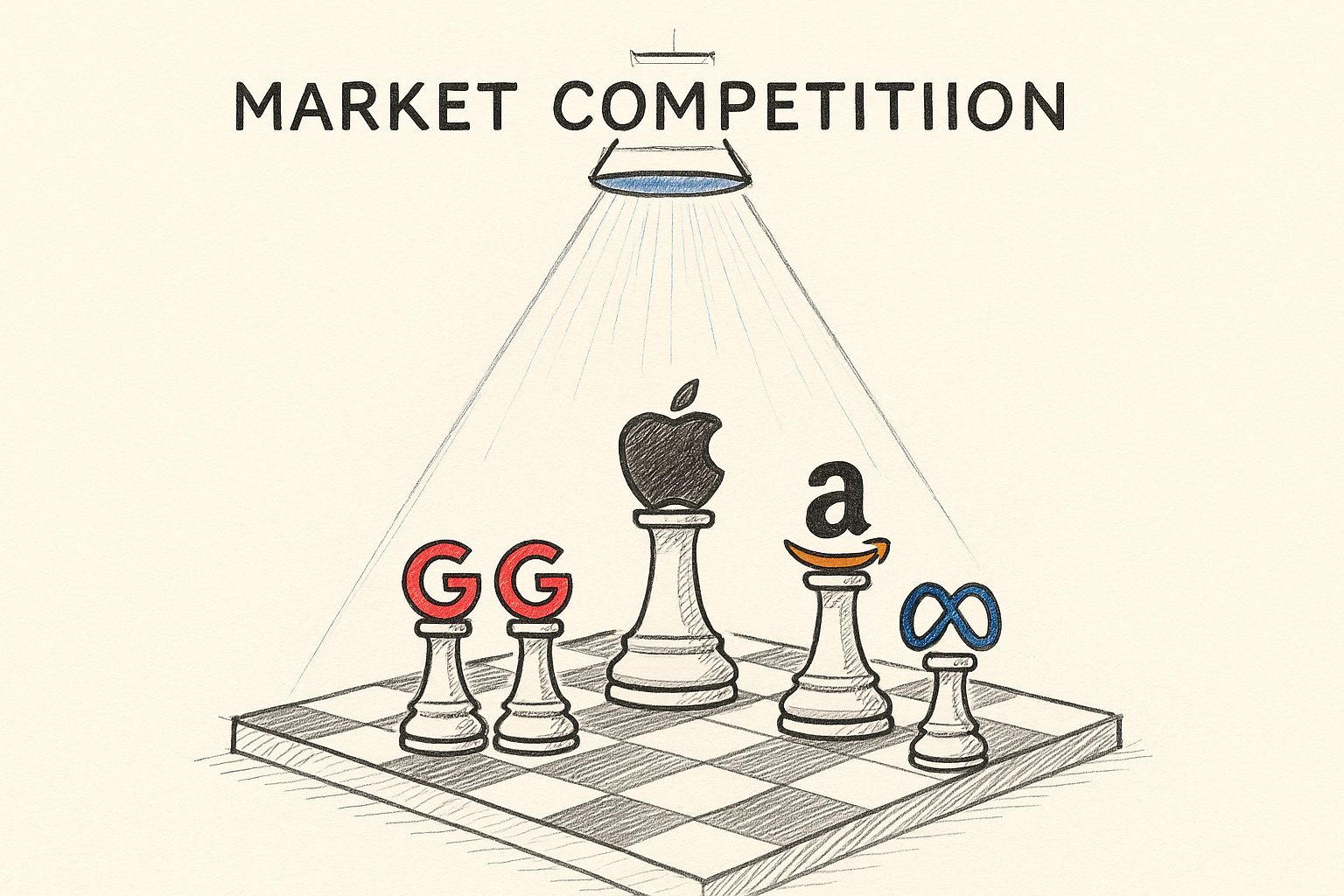A Guide to Competitive Advertising

Maxime Dupré
10/9/2025

Competitive advertising is a simple idea at its core: you're not just telling people why your product is great; you're showing them why it's better than the other guy's. It's about drawing a direct line between your solution and a competitor's, then making a clear case for why you're the superior choice.
This strategy is all about persuasion—moving beyond a simple list of features to actively capture market share from your rivals.
What Is Competitive Advertising Really About?
Think of the marketplace like a crowded stage where every brand is trying to grab the audience's attention. Just shouting about your own merits won't cut it. Competitive advertising is like delivering the most memorable, compelling lines that make everyone tune out the other actors. It’s a direct conversation with your audience, where you strategically contrast your brand against others to carve out a unique space in their minds.
This infographic paints a great picture of the market as a strategic chessboard, where every move is calculated to gain an edge.

It’s a perfect visual for how every ad decision—from the words you choose to the channels you use—is a deliberate play to outmaneuver the competition.
Building a Winning Position
The whole point is to build brand preference by proving you’re the best option available. This takes more than just knowing your own strengths; you need an almost obsessive understanding of your competitors' weaknesses. By zeroing in on those differences, you can shape how people see the market and guide them straight to your checkout page.
This is where the practice of competitive intelligence becomes your secret weapon. It’s all about gathering and analyzing information on your rivals to make smarter, more strategic decisions. You can learn more about how to get started in our complete guide to competitive intelligence.
A Nielsen study found that 59% of consumers actually prefer when brands provide clear comparisons. It helps them feel more confident in their choices, which just goes to show how powerful it is to show—not just tell—why you're better.
To give you a clearer picture, let's break down the core ideas behind this strategy.
Table: Key Dimensions of Competitive Advertising
| Dimension | Description | Primary Goal |
|---|---|---|
| Positioning | Defining your brand in relation to competitors to highlight unique value. | To create a distinct and memorable identity in the consumer's mind. |
| Differentiation | Actively showcasing specific features or benefits that your rivals lack. | To provide tangible reasons why your offering is the superior choice. |
| Persuasion | Using comparative messaging to influence consumer preference and purchase decisions. | To win over customers who are actively considering other options. |
Each of these dimensions works together to build a powerful narrative that positions your brand as the undeniable winner.
Why It Matters in Today's Market
Let's be real—the advertising world is incredibly loud. Global ad spending recently hit nearly $1.1 trillion and is on track to pass $1.15 trillion next year. With digital ads making up around 72.7% of that, you can’t just throw money at a campaign and hope for the best. You have to be smarter and more targeted.
Ultimately, a solid competitive advertising strategy helps you nail a few crucial objectives:
- Differentiate Your Brand: It lets you cut through the noise and clearly state what makes you different.
- Capture Market Share: You can proactively pull customers away from your competitors.
- Educate Consumers: You make their lives easier by simplifying the comparison process, which builds trust.
Choosing Your Competitive Advertising Strategy
Jumping into competitive advertising is one thing, but picking your angle of attack is a whole different ball game. The right move really depends on where you sit in the market, what your brand sounds like, and honestly, how much risk you're willing to take on. Not every fight needs to be a head-on clash; sometimes the smartest plays are the quietest ones.
Think of it as choosing how you want to tell your story. Are you the scrappy upstart calling out the heavyweight champ? The established leader swatting away imitators? Or the innovator who's busy creating a category all their own? Each approach has its own playbook and its own potential payoff.
Direct Comparison: The Head-to-Head Challenge
This is the most in-your-face strategy you can choose. You’re calling out a competitor by name and putting your product right next to theirs, comparing everything from features and price to performance. The classic "Pepsi Challenge" is a perfect example, where they put Coca-Cola to a blind taste test and got people to rethink their go-to choice.
This tactic really shines when you have a clear, undeniable advantage that’s easy for people to grasp. In fact, one study found that 59% of consumers actually like these kinds of direct comparisons because they cut through the noise and make choosing easier.
But this is a high-stakes game. You need to be aware of the risks:
- Legal Headaches: Every claim you make has to be 100% true and provable. If you can’t back it up, you could find yourself in legal hot water.
- Brand Image: If you don't nail the tone, you can come off as desperate or just plain petty, which is never a good look.
- Waking the Bear: A direct punch usually gets a punch back. Be prepared for your competitor to retaliate, which could kick off an expensive ad war.
Indirect Comparison: The Subtle Jab
Indirect comparison is a bit more of a chess move. Instead of naming names, you just drop hints about "the other guys" or point out a well-known weakness of the market leader. This lets you frame yourself as the better option without officially starting a fight.
Avis mastered this with their legendary "We Try Harder" campaign. They never had to say the word "Hertz." Everyone already knew who number one was, and the message was clear: the underdog has to work harder for your business than the guy at the top.
This strategy is all about planting a seed of doubt. You’re nudging customers to connect the dots themselves. When they arrive at the conclusion on their own, it feels like their idea—and that’s far more powerful than you just telling them.
Brand Positioning: The Different Path
Sometimes the best way to win is to change the rules of the game entirely. This strategy isn’t about being better on a checklist of features; it's about being fundamentally different. You carve out your own unique corner of the market by focusing on what makes you, you.
Apple’s iconic "Think Different" campaign is the gold standard here. They didn't waste time talking about processor speeds or RAM. Instead, they built an entire identity around creativity, rebellion, and challenging the norm. The choice wasn't just about a Mac vs. a PC; it was about what kind of person you wanted to be.
This is often the strongest long-term play. It builds a kind of brand loyalty that can't be chipped away by a competitor who just released a slightly better feature. It changes the customer's question from "Who is better?" to "Who is for me?"
How to Analyze Your Competitor's Playbook
If you want to outsmart your competition, you first need to understand their game plan. This isn't about a quick glance at their ads; it's about becoming a detective. You're building a complete dossier on their advertising strategy, looking for the cracks and gaps your brand can exploit.
Start by digging into their core messaging. What story are they telling their customers? Are they hitting on specific pain points or trying to stir up certain emotions? Pay close attention to the themes, taglines, and value props that pop up again and again. This tells you exactly how they want their audience to see them.

Tools like the one above give you a bird's-eye view of a competitor's advertising footprint. You can see their ad copy, the creative they're running, and even get an estimate of how much traffic those ads are driving. This is ground zero for mapping out their entire digital strategy and figuring out where their money is going.
Pinpointing Ad Spend and Channel Focus
Once you’ve got a handle on their messaging, it’s time to follow the money. Where a competitor spends their ad budget tells you everything about their priorities. Are they all-in on Google Ads? Or are they pouring cash into social media platforms like Meta and TikTok? Maybe they’re focused on display networks instead.
This is where competitor intelligence tools really shine. They do the heavy lifting for you, digging up crucial details like:
- Estimated Ad Spend: A solid estimate of what they're spending each month or quarter.
- Campaign Frequency: How often they’re pushing out new campaigns or swapping creatives.
- Targeting Tactics: The exact keywords they're bidding on and the audiences they're trying to reach.
This kind of intel helps you piece together their customer acquisition strategy and, more importantly, spot the channels they might be overlooking. For instance, if a rival completely dominates paid search, you might find a wide-open opportunity on social platforms or through a smart content marketing play. Their off-page SEO is another piece of the puzzle; check out our guide on how to find backlinks on Google to see how they're building authority.
The goal here is to map their entire advertising ecosystem. Once you know where they are, you can decide whether to go head-to-head on their home turf or find less crowded ground where you can score an easier win.
Evaluating Creative and Performance
Finally, it’s time to dissect their creative. How are they actually grabbing people’s attention? Analyze everything—their visual style, their tone of voice, and the calls-to-action (CTAs) they use. Are they leaning on video, static images, or user-generated content? Each choice is a clue about their brand and what makes their audience tick.
Let's face it, the advertising world is massive. A giant like Alphabet is expected to pull in over $200 billion in net digital ad revenue. In a market that crowded, creative choices can make or break a campaign. We know from industry benchmarks that video can boost conversion rates by up to 70%, and mobile native ads can get 8.8 times higher click-through rates than boring old display ads.
By studying your competitor’s creative, you get to learn from their wins and their losses without spending a dime of your own budget. You can dig deeper into these kinds of advertising benchmarks in a report from Wordstream.
Winning on the Right Channels and Platforms
Knowing what your competitors are saying is only half the battle. Knowing where to say it better is how you actually win. A brilliant message will completely miss the mark if it never reaches the right people, and choosing your channels wisely is what makes sure every dollar you spend is working for you.

The goal isn't to be everywhere at once. It’s about being smart and identifying the key battlegrounds where your target audience is paying attention. Then, you show up with a message that truly resonates.
Paid Search Conquesting
One of the most direct ways to go head-to-head with a competitor is by bidding on their branded keywords in paid search. Think about it: when a potential customer searches for a rival by name, your ad shows up right alongside theirs, presenting a compelling alternative at the exact moment they're making a decision.
Now, this tactic requires a bit of finesse. You can't be misleading in your ad copy, but you absolutely can highlight what makes you the better choice. For instance, an ad could say, "Looking for [Competitor]? See why users are switching to our faster platform." You're intercepting their high-intent traffic and forcing a direct comparison on your terms. To pull this off, you need solid paid search intelligence to keep tabs on their bids and messaging.
Social Media Targeting
Social media platforms are a goldmine for competitive advertising because they let you get incredibly specific. You can create custom audiences of users who follow your competitors' pages or have engaged with their posts. This means you can drop highly relevant ads right into the feeds of people you know are interested in what you offer.
Imagine running a video ad on Instagram Stories targeting followers of your main rival. The ad could feature a customer explaining exactly why they switched to your product, focusing on a pain point your competitor is known for. It’s a subtle but powerful way to plant a seed of doubt.
This approach is so effective because you're reaching a pre-qualified audience. These users already understand the problem your industry solves, making them far more open to hearing about a better solution.
Display and Content Marketing
With display advertising, you can run "conquesting" campaigns by placing your banner ads on websites your rival's customers love to visit. By figuring out which blogs, news sites, and forums are popular in your niche, you can keep your brand top-of-mind with the right crowd.
Content marketing, on the other hand, is the long game. By creating genuinely helpful blog posts, guides, or tools that outrank your competitors for key search terms, you start capturing organic traffic. This strategy positions your brand as the go-to authority, building trust and winning over customers before they even think about looking elsewhere. And remember, this is a global game—high-growth markets like India and Indonesia are rapidly shifting toward social and video, so a one-size-fits-all approach won't cut it.
Measuring What Matters in Your Campaigns
https://www.youtube.com/embed/sflvJTQLNww
Running a competitive ad campaign without tracking the right numbers is like steering a ship in a storm with no compass. You're definitely moving, but are you getting any closer to your destination? To really know if your ads are hitting the mark, you need to get familiar with your advertising performance metrics.
It's tempting to get caught up in flashy but hollow numbers like impressions or social media likes. The real trick is to zero in on the data that ties your ad spend directly to business growth. Getting past these surface-level stats is the only way to prove your campaigns are delivering a real return.
Key Performance Indicators for Competitive Ads
When you’re specifically targeting competitors, your goals are different. You’re not just building awareness; you're actively trying to win over someone else's customers. Your dashboard needs to reflect that.
So, what should you be watching? Here are the heavy hitters:
Share of Voice (SOV): Think of this as your brand's slice of the conversation pie. A rising SOV means your ads are successfully elbowing competitors out of the way and grabbing more of your shared audience's attention.
Click-Through Rate (CTR) on Competitor Keywords: This is a big one for paid search. If you're bidding on a rival's brand name, a high CTR is proof that your ad copy is compelling enough to lure searchers away from their intended destination.
Conversion Rate from Conquesting Campaigns: Here's where the rubber meets the road. This number tells you how many people who clicked your competitor-focused ad actually followed through and did what you wanted them to do, whether it's signing up for a trial or buying a product.
Customer Acquisition Cost (CAC): How much are you actually paying to get a new customer from these specific campaigns? You need to know this. Comparing your competitive CAC to your other marketing channels tells you if this strategy is just effective, or if it's cost-effective.
It’s not just about getting clicks; it's about acquiring the right customers efficiently. A low CAC from a competitive campaign means you're not just winning battles—you're winning them profitably.
To give you a clearer picture, I've broken down some of the most important metrics you should be tracking based on what you're trying to achieve with your competitive ads.
Essential Metrics for Competitive Ad Campaigns
| Metric | What It Measures | Why It's Important |
|---|---|---|
| Share of Voice (SOV) | Your brand's visibility versus competitors across key channels. | Shows if you're successfully capturing attention and dominating the conversation in your market. |
| Click-Through Rate (CTR) | The percentage of people who see your ad and click on it. | For competitor keywords, a high CTR means your message is effectively intercepting their audience. |
| Conversion Rate | The percentage of clicks that result in a desired action (e.g., sale, signup). | The ultimate measure of whether your ad convinced someone to switch from a competitor to you. |
| Customer Acq. Cost (CAC) | The total cost to acquire one new customer from the campaign. | Determines the profitability and sustainability of your competitive advertising efforts. |
| Return on Ad Spend (ROAS) | The revenue generated for every dollar spent on advertising. | Provides a clear financial justification for your competitive campaigns by linking spend directly to revenue. |
| Brand Sentiment | The overall tone of conversation (positive, negative, neutral) around your brand. | Gauges public perception of your competitive tactics—are you seen as a strong alternative or just aggressive? |
Ultimately, a mix of these metrics gives you the full story. You can see not only if you're winning customers but also if you're doing it in a smart, profitable way.
Looking Beyond the Numbers
While the data is your north star, don't forget the human element. Monitoring brand sentiment with social listening tools can tell you how people feel about your competitive ads. Does your messaging make you look like a confident industry leader, or are you coming off as a desperate copycat?
Bringing these two worlds together—the hard numbers and the audience perception—is what separates good campaigns from great ones. It gives you a complete, 360-degree view, allowing you to fine-tune your strategy so that every move is backed by data and delivers real-world results.
Staying Within Ethical and Legal Boundaries
Let's be honest: aggressive marketing can feel like walking a tightrope. A bold, assertive campaign can grab a huge chunk of market share, but one wrong move could land you in legal hot water and do serious damage to your brand's reputation. Knowing the rules of competitive advertising isn't just a good idea—it's absolutely essential.
The line between a clever jab and an illegal claim is often surprisingly thin. If you make a statement you can't prove or a comparison that misleads customers, you're opening the door to lawsuits and big fines from regulators like the FTC. The golden rule? Every single claim you make about a competitor must be 100% verifiable and factually accurate.
Navigating Key Legal Pitfalls
To keep your campaigns both hard-hitting and above board, you need to be very careful in a few key areas:
- Trademark Infringement: You can usually mention a competitor's name to make a comparison, but you can't ever suggest they endorse you or create confusion about whose ad it is. The distinction between your brand and theirs has to be crystal clear.
- False Advertising: Any claim you make, whether it’s about your product or theirs, needs to be backed by solid proof. Saying your software is “50% faster” isn't just marketing copy; it's a factual claim that requires data to support it. Without it, you're risking a false advertising lawsuit.
- Data Privacy: Going after your rival’s audience means you're handling user data, and you have to do it right. All of your ad campaigns and platforms must comply with major privacy laws like GDPR and CCPA.
Sticking to the rules isn't about holding back your creativity. It's about building a strategy that lasts. Consumers are smart, and they'll quickly turn on a brand that relies on cheap shots or dishonest claims.
The Importance of Data Compliance
As you get smarter with your competitor research and audience targeting, data privacy becomes even more critical. To get a better handle on industry standards, it's worth reading up on things like the IAB's New Data Privacy Framework. Keeping up with these guidelines ensures your targeting is not only powerful but also completely ethical.
At the end of the day, the goal is to be assertive, not reckless. A smart competitive advertising strategy takes on rivals based on merit, shines a light on your real strengths, and plays by the rules—protecting your brand for the long run.
Answering Your Top Competitive Advertising Questions
Even with a solid plan, it’s natural to have questions when you're thinking about going head-to-head with a competitor. Let's clear up a few of the most common ones.
Is It Actually Legal to Name a Competitor in an Ad?
Yes, in most places like the United States, it's perfectly legal—as long as you play by the rules. The key is that every claim you make must be truthful, accurate, and impossible to misconstrue.
You can't stretch the truth about their product or use their trademark in a way that just causes confusion. In fact, the Federal Trade Commission (FTC) is all for comparative ads, because they believe it helps people make smarter buying decisions.
What’s the Single Biggest Risk I’m Taking?
Honestly? The biggest risk is shooting yourself in the foot and damaging your own brand’s reputation.
If your campaign comes off as petty, dishonest, or just plain mean, it can seriously backfire. Customers can see right through it, and instead of winning them over, you just look insecure. People respect confidence and hard facts, but they tend to tune out when they see what looks like a cheap shot. A poorly planned ad won't just turn off your audience; it might even make them feel sorry for your competitor.
How Do I Know if This Strategy Is Right for My Brand?
This approach works best for challenger brands that have a clear, undeniable advantage over the big fish in the market. It's also a powerful tool in a jam-packed industry where it feels impossible to stand out.
Before you even think about launching a campaign, have an honest conversation with your team. Can you back up every single claim with solid proof? Does this aggressive style even fit our brand's personality? If you hesitate on either of those, it might be smarter to find another way to compete.
Ready to stop guessing what your competitors are doing? ChampSignal delivers high-signal alerts on your rivals' marketing moves, from ad creatives to pricing changes. Start your free trial today and turn their playbook into your advantage.
Get Started
Competitor Monitoring That Doesn't Suck
Spend under two minutes per week monitoring your competitors. Receive only the information that matters.
Join other SMBs on top of their competitors.

